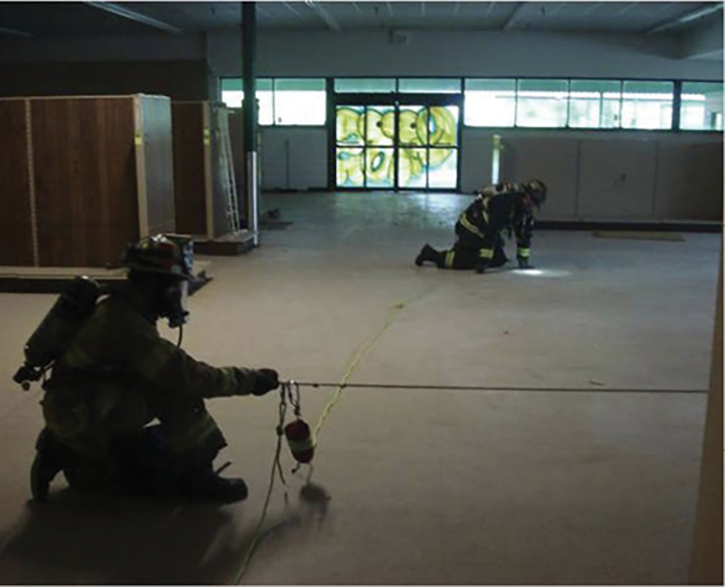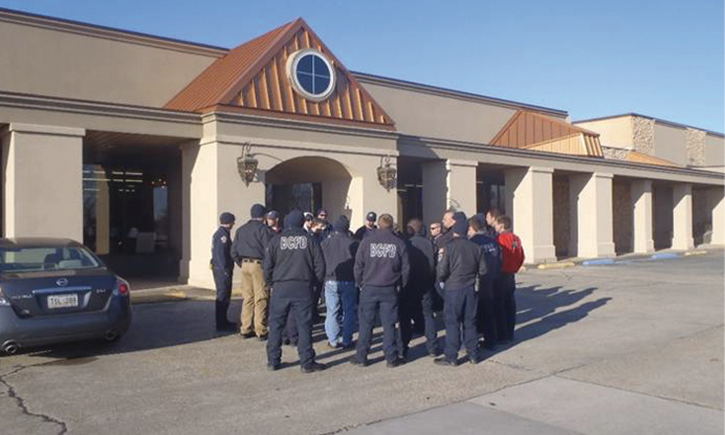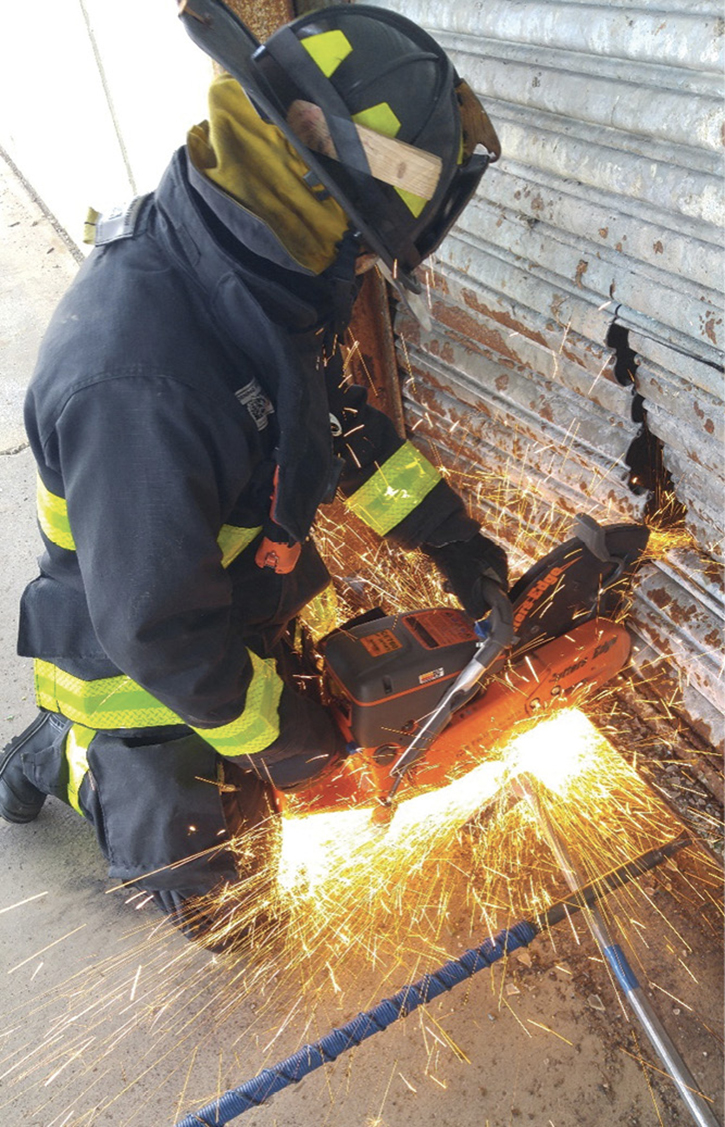
Over the past few years, fire service members, including myself, have emphasized the importance of adopting strategies and tactics specifically designed and proven to work effectively at commercial fires. Still, some departments have not embraced this commonsense approach, although many have come to understand the need to be more proactive when confronted with commercial building fires. Unfortunately, we can only lead some firefighters and departments to water but cannot make them draft it! This article provides firefighters, company officers, and chiefs with the next step in the commercial fireground tactics process: developing training priorities and commercial fire guidelines/procedures.

(1) Firefighters preplanning a converted commercial target hazard in their first-due area. Originally a movie theater, this structure is now a furniture showroom and warehouse. (Photos by author.)
RELATED FIREFIGHTER TRAINING
10 Commandments for Operations in Small Box Stores with Limited Staffing
Training Priorities
1. Assess the Potential and Preplan
Assess the potential for commercial fires in your response area. Note the presence of big-box stores, strip malls, manufacturing facilities, warehouses, industrial processing plants, office complexes, convention centers, gas stations, hotels, mom-and-pop stores, and the typical occupancies of downtown Main Street USA to name a few.
Once your inventory is complete, it’s time to get in these structures to preplan. Note the important construction features like mezzanines, bowstring trusses, lightweight I-beams, C-joists, and bar joists along with hazards such as chemicals, flammable stock, and challenges presented by loading docks and roll-down garage doors personnel may confront (photo 1). Many commercially produced applications, programs, and forms can assist you with this process.

(2) An engine company practicing rural water-supply operations using portable tanks.
If gaining building access is a problem in your community, work as closely as possible with your local code enforcement agencies. In many cases, these agencies have much valuable information that they never provided to the fire department or that we may have overlooked during preplanning. When completing your preplans, ensure that your crews consider the department’s accepted tactics. Understanding your hoseloads and hose stretches, portable ladder and aerial apparatus limitations, water supplies, tool caches, crew sizes, and mutual-aid response packages is a critical part of this planning.
2. Get Water on the Fire
Getting water to the seat of the fire, overpowering it, and making good things happen for everyone involved on the fireground is the next consideration. Remember, the faster we accomplish the knockdown and extinguish the fire, the more money we save for our community and our tax base (yes, there is a direct correlation). This may include the use of a blitz attack, dumping the booster tank by way of a prepiped deck gun because of the heavy fire load and the possibility of fire extension.

(3) Firefighters perfecting their 2½-inch hoseline skills.
Any good engine company has a solid understanding of its water delivery system, whether it’s a municipal or private water system. In rural operations, the system comprises water tenders, ponds, lakes, or holding tanks. Train your personnel on how to access the water, move it, and get it to where it is needed in a timely and safe manner.
Knowing that commercial structures generally require much higher fire flows than the typical one- and two-family dwellings, train to meet this expectation and ensure that your companies can provide water under all types of conditions (including ice-covered ponds/lakes). Challenging conditions you may have to overcome include severe weather, dead hydrants, less than optimal water delivery systems, and even drought conditions (photos 2-3).
With the need for higher water flows comes the need to push large-caliber hoseline training to a much higher level. Commercial structures necessitate that our firefighters perfect their stretches of attack lines of 2-, 2½-, and even 3-inch leader lines (also known as apartment stretches or tenement lines). Hose packs are no longer just a requirement in cities and high-rise operations. Having our engine companies well-versed in the use of hose packs designed for the horizontal stretch as well as the vertical stretch should be a high priority for the commercial building fire. When engine companies fail at these basic fireground tasks, the failure rests squarely on the lack of training and preparation.

(4) Truck company members drill on rotary saw operations on a commercial building.

(5) Personnel practicing rope-assisted search in an abandoned box store.
3. In-Depth Training
Create an in-depth and structured plan for sharpening your companies’ skills. Truck work on the commercial fireground differs greatly from our bread-and-butter house fires. Everywhere we turn, crews are practicing forcible entry on a door prop of some sort, but how many are simulating multiple locking devices and homemade anti-intrusion devices and performing these skills in less than optimum environments? This is critical training.
Additionally, it is imperative that our firefighters are proficient and comfortable with rotary saws. The ever-increasing additions of roll-down gates, overhead doors, drop bars on rear doors, and interior chain link fencing make rotary saws a necessity both on the exterior and interior of many commercial buildings (photo 4). While out preplanning and gaining building recon information, highlight and share specific forcible entry challenges with operating companies. Address aerial apparatus positioning as well. If we don’t position them properly at the beginning of an incident—even though we have adequate space to set them up—it becomes increasingly difficult to reposition them in the heat of the battle.
Another often overlooked truck skill is working with larger portable ladders. Similar to an engine company that drills only with 1¾-inch hose, a truck that hasn’t trained intently on 35-, 40-foot, or larger portable ladders will be ill-prepared to make grabs from third-floor windows in local office buildings or multistory taxpayers. Even the basics of operating around parapets on commercial buildings should be a training topic for all operating personnel.
4. Large-Area, Rope-Assisted Search
Although most consider large-area, rope-assisted search a truck duty, it is definitely a widely misunderstood procedure that necessitates a great deal of training. Departments not equipped or trained in this discipline are bound to place their firefighters in precarious situations in which they will be destined to fail or, even worse, experience grave injury or death. Searching commercial structures without a search rope—or, as many call it, a lifeline—is often time consuming and extremely counterproductive. Once you have completed the assessment of your structures, implement a rope-assisted search guideline, a rope system, and training (photo 5).
There is no one set list of priorities that can be applied to every fire department; we all have different staffing levels, response plans, and hazard levels. The suggestions above set some wheels in motion and are reminders of our need to be proactive when preparing our firefighters for commercial fires. As the great United States Marine Corps General James Mattis says, “Wars don’t wait until you’re ready. The way you win is by being ready.” Prepare your crews for battle on the commercial fireground, and it will show in their performance!
AARON HELLER is a 36-year veteran of the fire service and the chief of Hamilton Township (NJ) Fire District #9. He has a B.S. degree in fire science from Columbia Southern University. Heller is a New Jersey level 2 instructor and presents at several training events worldwide and is a co-host of Fire Engineering’s Humpday Hangout on training. He owns On Scene Training Associates, LLC.

